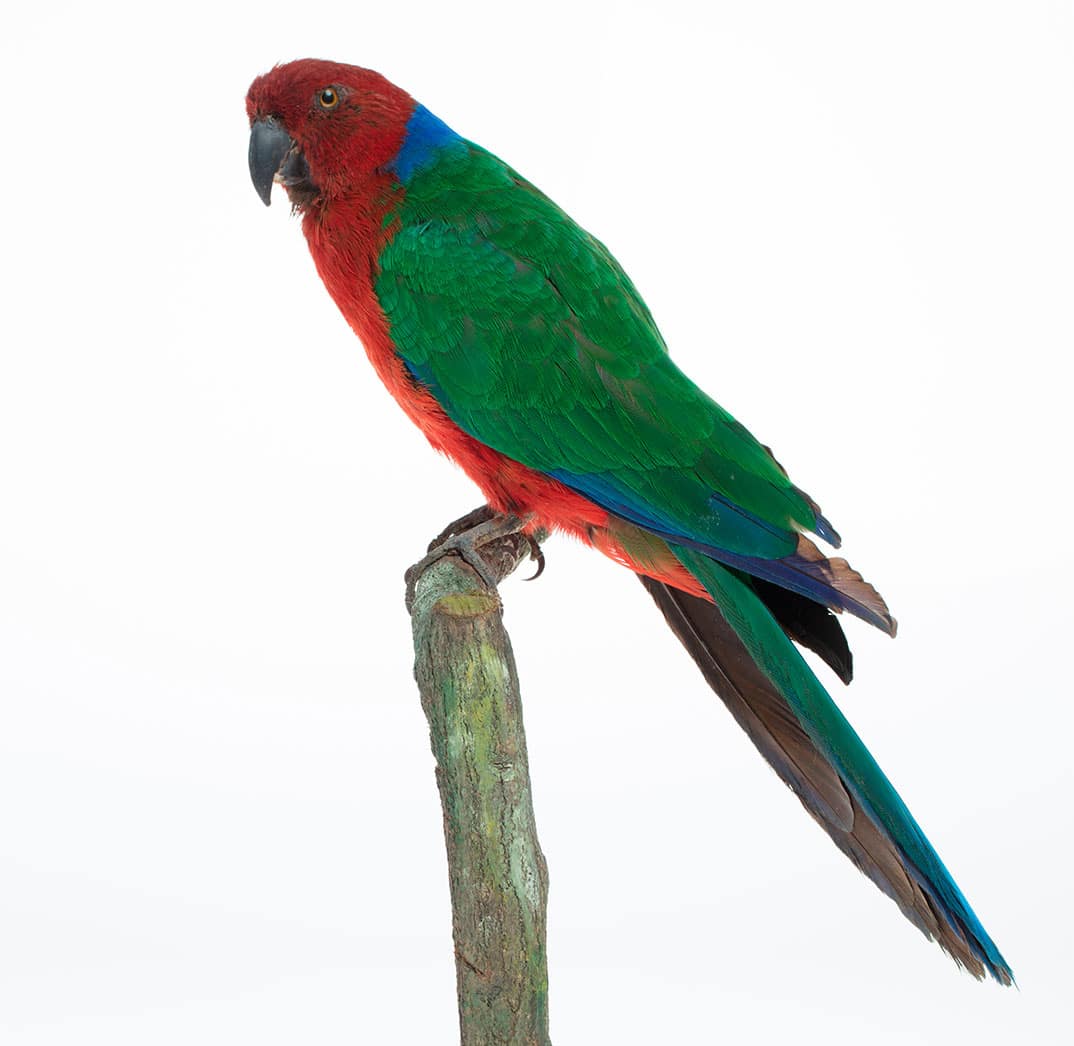Content
|
|---|
Description:
42 cm. length and 280 g. of weight.
The Crimson Shining-Parrot (Prosopeia splendens) is very similar to the Red Shining-Parrot (Prosopeia tabuensis). has the head and underparts red intense and bright, slightly darker in ears; broad collar rear violet-blue, which becomes turquoise toward the trailing edge. The rest of upperparts bright pale green with darker edges and fine bright in back and wings. Coverts medium green, greater coverts blue green; primary coverts and primaries deep blue-violet with black on innerwebs; secondaries blue to green in the innermost feathers. Underwing-coverts marked blue-green and red; axillary pale green. Uppertail green with blue tip, violet blue with side feathers innerwebs blackish; undertail black. Bill black; irises red-orange; legs black.
The male has the bill and head bigger
taxonomy:
It was generally considered consanguineous with the Prosopeia Tabuensis, but may be closer Prosopeia Personata. Monotypic.
- Escarlata sound Papagayo.
Habitat:
It is found in forests, farmland and villages, both in the lowlands and hills.
Reproduction:
Food, habits and reproductive behavior presumably similar to those of the Red Shining-Parrot (Prosopeia tabuensis) With which, until very recently, was considered consanguineous.
Food:
Similar al al Red Shining-Parrot (Prosopeia tabuensis).
Distribution:
It is endemic Fiji, where it is found naturally in islas de Kadavu (including around Vunisea) and Ono. It has also been introduced in Viti Levu and probably in the Group Yasawa and Ovalau in the past (There are no recent records).
Conservation:
• Current category of the Red List of the UICN: Vulnerable
• Population trend: decreasing.
The species may be declining in Viti Levu due to trade, although at present the possible negative effects of competition are not known with Masked Shining-Parrot (Prosopeia personata). It is estimated that the world population lies between 5.000 and 10.000 specimens. NEAR THREATENED.
Justification of the population
Although recent fieldwork on Kadavu has not focused specifically on this species, seems to occur in population densities similar to those of Masked Shining-Parrot (Prosopeia personata) (86 Crimson Shining-Parrot They were recorded in Kadavu 38 standardized observation times in the two studies BirdLife, similar to the average 1,9 of the Masked Shining-Parrot /time recorded in 18 sites across the Viti Levu). The Masked Shining-Parrot It was estimated at around 29 in native lowland forest birds / km2 (Jackson y Jit 2004). The area of ​​dense forest and medium density Kadavu it's around of 225 km2 (National Forest Inventory 1991-1993), so a reasonable estimate of the population Crimson Shining-Parrot would be 6.000 birds or 4.000 mature individuals.
Conservation Actions Underway
Appendix II of the CITES. It is protected by law in Fiji, which has recently been revised, the old Law Poultry and game has been partly overtaken by the Law on Protection of Endangered Species, which provides protection (SPREP 2000, D. Watling a slightly. 2007). Conservation projects have reduced the trade in this species (Jackson y Jit 2004). Four communities have declared a protected area covering community 1.535 hectares of forest and local volunteers monitor bird populations and assess the state of the habitat on their own initiative (V. Masibalavu a slightly. 2007). Conservation actions aimed at fire prevention (including awareness following the amendment of the decree concerning arson) have improved in recent years (V. Masibalavu in litt. 2012, M. Tabudravu in little. 2012).
Conservation Actions Proposed
Establish standards for maintenance of parrots in captivity to reduce demand (SPREP 2000). Monitor the numbers caught and transported to Suva. Determining population densities in various habitats. Investigate breeding needs and success. Promote the creation of community forest reserves. Use as set species to promote ecotourism in Kadavu.
"Crimson Shining-Parrot" in captivity:
Captive numbers are unknown., and everything indicates that captive breeding has rarely been achieved. It is caught in small quantities, and islanders returning to the capital, Suva (Watling 2000), the birds are carried as a gift, and there is at least some illegal trade abroad (J. S. Kretzschmar a lie. 2000).
In the nineteenth century it was imported by zoos in London, Berlin and Hamburg. In the United States, He kept San Diego Zoo, which was partially successful with the offspring when a young man born in 1973,
As they are at serious risk of extinction, only the most experienced should attempt to keep them in their aviaries, and all captive bred should be better placed in breeding programs to establish a larger population and participate in the conservation of this bird species.
Alternative names:
– Crimson Shining Parrot, Crimson Shining-Parrot, Kadavu Shining Parrot, Kandavu Shining Parrot, Kandavu Shining-Parrot (inglés).
– Perruche écarlate, Perruche masquée écarlate (francés).
– Fidschi Sittich, Fidschisittich (alemán).
– Papagayo Escarlata (portugués).
– Papagayo Escarlata, Papgayo Escarlata (español).
Clasificación científica:
– Orden: Psittaciformes
– Familia: Psittaculidae
– Género: Prosopeia
– Nombre científico: Prosopeia splendens
– Citación: (Peale, 1848)
– Protónimo: Platycercus splendens
Imágenes Papagayo Escarlata:
Videos del "Papagayo Escarlata"
Fuentes:
• Avibase
• Parrots of the World – Forshaw Joseph M
• Parrots A Guide to the Parrots of the World – Tony Juniper & Mike Par
• Birdlife
Fotos:
(1) – Auckland Museum [CC BY 4.0]
- Sonidos: Matthias Feuersenger, XC109256. Accesible en www.xeno-canto.org/109256.



